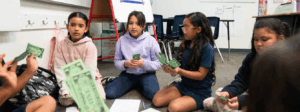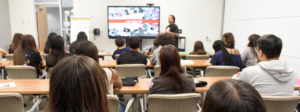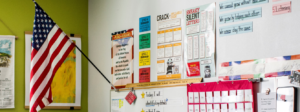At TNTP, we are committed to ensuring that multilingual learners have the linguistic supports they need to access grade-level appropriate, engaging, and culturally sustaining academic experiences. During Multilingual Learner Advocacy Month, we are honored to share the personal perspectives of former multilingual learners on opportunities and challenges from the field.
In this blog, we’ll hear from Susana Sotelo, TNTP’s Multilingual Learner Advocacy and Partnerships intern. She is currently a sophomore at the University of California, Berkeley, where she is majoring in psychology.
We invite you to join TNTP and Next100 on April 13 at 6 p.m. Eastern for a panel discussion on effectively supporting newcomer students. Register for the panel here.
What drew me to becoming a student teacher was eventually being the educator the younger me would have appreciated and related to at school. Growing up, I did not have a bilingual educator or staff member with whom I could talk and relate in Spanish, my native language. While I was student teaching in a school that served predominantly multilingual learners (MLs), I worked in four preschool classrooms where most teachers only spoke English.
In one class, I noticed a student who was generally quiet and kept to herself. She wouldn’t participate in activities or communicate her needs to her teacher. When I asked her if there was another language she felt comfortable speaking, she told me Spanish. With Spanish as my native language, I was able to talk with her in her first language, and over time, she began to open up with me. The classroom teacher could only communicate with the mostly ML students in English, so when she noticed our connection, she asked if I could help by translating what the student needed.
My experiences have shown me that our ML students urgently need educators—particularly bilingual educators—who can create supportive and academically challenging environments. But, far too many schools are struggling to hire and retain multilingual educators. More broadly, the need for educators who are equipped to support multilingual learners, especially in communities where most students are multilingual learners, is dire and merits more attention.
Data collected by the U.S. Department of Education on Teacher Shortage Areas indicate that between 2018-2023, 27 states have listed a shortage area in English as a Second Language (ESL) certified educators, which includes the category of bilingual educators. For the upcoming school year, 13 states have already projected shortages in ESL educators. Shortages have been reported in states such as Texas, Florida, New York, Illinois, and Virginia, which have diverse student populations with significant percentages of multilingual learners.
The data collected in these national reports are imperfect in that they do not provide the specific number of teachers required for states’ student populations, and there are variations across states in what teacher areas are reported on. But overall, the data suggest that there are many multilingual learners who do not have access to teachers equipped to support their English language development, much less sustain their home language and be placed on a trajectory that promotes and allows them to tap into the multiple benefits of multilingualism.
It’s simple: A student’s home language should not hinder them from accessing a sound education. Every child has the right to learn, and every teacher should be effectively trained to teach their students in culturally and linguistically sustaining ways.
In TNTP’s work supporting teachers in maintaining high expectations for multilingual learners in math, we’ve seen that many MLs do not receive consistent access to grade-level work. For example, delivering a high-quality, inclusive math curriculum requires more than just calling out some vocabulary in class, as has often been the case. It includes recognizing that multilingualism is an asset for learning acceleration.
Fortunately, the U.S. Department of Education has awarded nearly $120 million over five years under the National Professional Development Program (NPD) to support educators of multilingual learner (ML) students. These investments have encouraged educator preparation programs and districts to implement professional development opportunities to help educators and staff improve instruction for MLs.
In Wisconsin, for example, the Board of Regents of the University of Wisconsin System will be using its funds in the PIECE project, which equips inclusive early childhood educators with the knowledge and skills to provide high-quality instruction that will improve outcomes for MLs. And in Ohio, the University of Cincinnati will use its funds to create a web-based app that will collect data from 80 educators to improve early community-based supports, transition to kindergarten, and other learning opportunities.
These approaches would have made a world of difference in making language feel like less of a barrier to my learning as a child. Today, they can improve the education of the little girl I taught and the millions of multilingual learners nationwide. It is encouraging to see many states across the country implementing new and creative ways to improve instruction to better meet the needs of multilingual learners, but we still have a long way to go.
Join the conversation during Multilingual Learner Advocacy Month (and beyond)! This Thursday, April 13 at 6 p.m. ET, TNTP and Next100 will host a virtual panel that will delve into the leading practices, research, and policies to effectively support newcomer students at scale. Register for the panel here.








